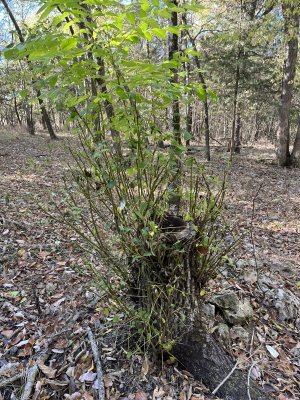My first property was 13 acres of timber in SW Missouri, which I still enjoy. While we have harvested some nice deer from the property, there is no way I can hold deer on the property--although it sure seems as some doe's have adopted the place as their "go to" property. Here are some reflections of the work I have done that may be helpful to this thread:
Hinge Cutting: That was all the rage ten years ago, and I hinge cut several smaller maples, oaks and elms to create funnels from the neighboring pasture land. Several died in two years, and all but one are dead today. However, the cuttings did create the desired funnel that is used to this day. Would I do this again? No.
Timber Management: This was key--getting more light to the ground--plus it's provided some great firewood for the cabin. I continue to engage in timber management using girdling.
Mineral site: In placed a trophy rock by a desired "pause point" in a 1/3 acre hidey hole that has become THE messaging center for bucks and does for the past decade. The scrape is 5' wide and I have not added any minerals for a couple of years.
Mineral stumps: Some of my stumps have produced for five years and are still being hit hard. This provides the added benefit of timber management. I will continue this practice.
Hidey Hole plot: A 1/3 acre plot has performed "as advertised," meaning that the deer stop and browse. I used the brush from cleaning the plot to create cover. It is not unusual to have six or seven deer behind the cover and then water into the plot, check out the mineral site and go back into the cover. Over the decade, I have expanded the plot from 1/4 acre to 1/3 acre.
Reflections: Since the 13 acre "cabin" property is not one I frequent, I do not want to engage in improvements that require much equipment or time. I do want quality habitat and periodic hunting opportunities. Small properties can provide big opportunities, and my most memorable hunt was the year I harvested a "textbook buck" that I would have never harvested had it not been for the above improvements.


